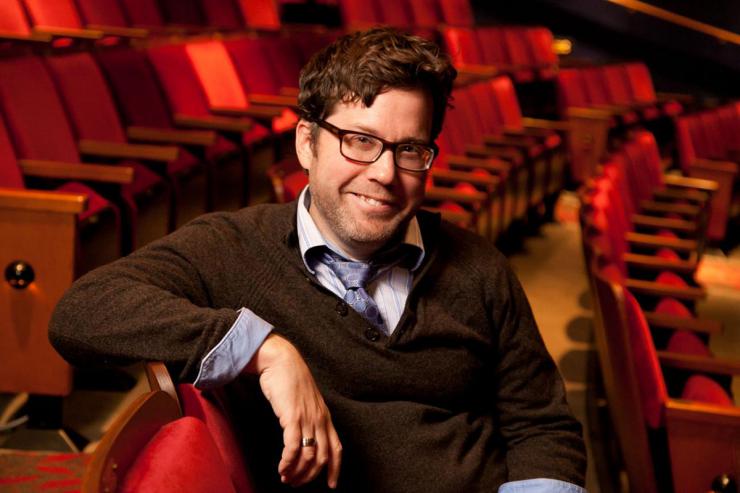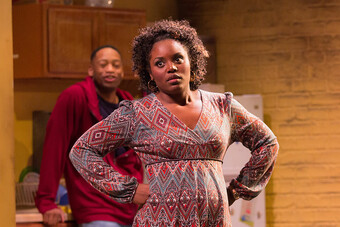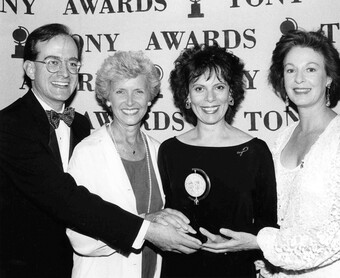Interview with Sean Daniels
Margot Melon: How would you describe the job of associate artistic director?
Sean Daniels: I ran a session for associate artistic directors two TCG conferences ago. The first thing we did was go around the room and everybody had to say what they do. The job can mean anything: you direct four shows per year, or you’re there to be the conscience of the institution, or you do casting, or you help the budget line because you can do so many things at one time, or you’re a mentor. We asked the question, how many of you believe that you are being mentored to run an institution? Every single person raised their hand. And then we asked, how many believe you are being mentored to run your institution? And nobody raised their hand.
Margot: Like the presidency, is there a clear line of succession in the American theater?
Sean: I have often referred to myself as the Joe Biden of Actors Theater. I don’t think the role is set up to be the automatic successor. I think the role is set up to encourage someone as an artist. And also when an artistic director leaves, the organization has to reassess what it wants to do. I think it would be a little Alexander Haig to suddenly run out and be like, “I am taking over all of this and this is the way it’s supposed to be.”
One thing I think is fascinating about associate artistic directors is they have to be the cockiest humble people you know. They’re in a position to step in front of an audience and talk with excitement about programming, shows that are coming up, and be the rock star of that event. And also humble because at any given moment, the artistic director might say, “You’re actually not talking to the donors tonight because I made my schedule work.” And they have to be like, “That is awesome.” Because that’s what the institution needs. The institution doesn’t need you running around saying, “Well, that’s not what I would have done.” The institution needs you to be able to provide that kind of support.
Margot: Would you say that it’s primarily an artistic role or an institutional role?
Sean: I think it can be both. I think the really brave artistic directors choose associates they feel bring strengths to the institution that they don’t have.
Margot: Institutionally, the associate has to support the artistic mission established by the artistic director. Behind closed doors, how is that relationship different?
Sean: I don’t think Marc Masterson said, “fuck you” to me until the second year I was here. That’s when I knew it was going to work out. When I first got here he said, “One of your jobs here is to push and to question and to bring a fresh perspective.” I’m more of a gunslinger and he’s more of a poker player. I came in, and, as a gunslinger, wanted to change everything and a) he was able to walk me through how you actually make change happen, and b) if this is a house metaphor, he helped me to learn what walls were just for show, and what walls are structural, what can you tear down, and what will end the institution, and c) he taught me not to mix metaphors, but I wasn’t as good at learning that, hence this answer.
One thing I think is fascinating about associate artistic directors is they have to be the cockiest humble people you know. They’re in a position to step in front of an audience and talk with excitement about programming, shows that are coming up, and be the rock star of that event.

Margot: So the most successful partnerships between artistic directors and associates are ones where they complement each other or where they embrace a difference of artistic aesthetic?
Sean: I don’t know that one is more successful than another. Marc was a mentor of mine for a long time before I took the job here. For us it was an opportunity for that mentorship to continue or take it to the next level. Theater people are fantastic about giving advice but there is something about being in the building with someone, working with them, and watching them grow as an artist.
Margot: You can’t really study to be an artistic director. Mentorship is really important in terms of grooming the next generation of artistic directors, right?
Sean: I think it’s incredibly invaluable. There’s something about learning to navigate a large institution, not just how you navigate it but how you marshal the resources institutions have. The real benefit of institutions is that they have resources you can use to accomplish things you might not be able to on your own. I don’t know if I would have been able to go straight from running Dad’s Garage to running a $10 million institution. They’re both running institutions, but in terms of the complexity and what it means to be at the center for theater in your community (like Actors Theater is in Louisville), that is something I’m very lucky to have had someone to walk me through. The great thing about a true mentorship, like I think we have, is that he’s not training me to be Marc Masterson. He’s training me to be the best version of me that I can be.
Margot: So do you think after four years at ATL you’re still a gunslinger or do you think you’ve evolved into more of a poker player?
Sean: Oh, no. When Marc Masterson is your boss you just kind of understand you’ll never be the poker player that he is. I’ve just moved over to blackjack. No, what’s great for me about being interim artistic director is I feel like I’m more of a sheriff of the theater than an artistic leader. When you’re the interim artistic director your job is to shepherd the theater through, to keep the excitement high, and the only difference is that everybody knows that you might not have the job in three months. The only power you have is through building consensus around ideas and building genuine excitement. When you’re the boss you can be like, “Listen, I’ve announced that we’re painting the theater blue and I will take no questions.” But when you’re the interim, it’s a great challenge to get everybody to believe that painting everything blue is in the theater’s best interest.
Margot: If you become an artistic director, what kind of associate artistic director would you look for?
Sean: I think I already promised Kristoffer Diaz he could do it. Whether it’s here or somewhere else, wherever I become artistic director, I hope I would have the same comfort level that Marc had, to be able to bring in someone who can question things, that there is a healthy, wonderful tension in pushing the institution to go farther and to do more.
Margot: Did you always want to be an artistic director?
Sean: At some point every director has to decide: Am I a freelance director or am I an institutional person? And I think a long time ago I decided I’m an institutional person because a) I love figuring out ways to make it possible for other artists to do their work, and b) I love that long-term conversation that goes on with a community when you can work with them several different times. I’d been here for six months before somebody came out from behind a tree and helped to push my car out of the snow. I rolled down my window and thought they were going to tell me something like, you probably shouldn’t be driving, you’re clearly from Florida. But instead they had a conversation with me about the show they had seen and how they’d really enjoyed it. You don’t get that kind of communication with an audience if you’re a gun for hire and you leave the day after the show opens. The downside is when the bad reviews come out you don’t get to get on a plane the next day—you’re still going to run into your audience at the grocery store.
Margot: Is there a sense of frustration on the part of associate artistic directors in that they spend a lot of time investing in one company, but in order to advance they have to go to another company?
Sean: I think most people think of it really as a great launching ground, to be able to do a lot of work and then be able to move on to the next thing. Once you move on to a new place it’s not as though everyone at the last place is dead to you. You keep those relationships.
Margot: Right. People bounce from one institution to another all the time.
Sean: Definitely. By the time this interview comes out, who knows what job Polly Carl will have? And that’s exciting to me. I actually think it’s healthier for people to move on at a certain point when they feel like they’ve accomplished what they wanted to accomplish.
Margot: What is the worst part of being an associate artistic director?
Sean: First of all, it’s the greatest gig in the American theater.
Margot: Okay. Why is it the greatest gig in the American theater?
Sean: Because you are supported by an institution to grow as an artist. At least my experience has been that. It’s impossible to work with someone who is accomplished enough to run an institution and not be able to learn from them. Where else do you get to work at your craft and grow at the same time? I think the complaint that people have as associate artistic directors is that they wish they had more control, that they were able to more readily choose what shows they did in the season, that they were able to have a stronger hand in the programming. Because ultimately, programming still comes down to taste and it still comes down to the taste of the artistic director. And that’s where you have to be humble. If you’re the associate artistic director, everyone is trained to know you as that; it’s hard to break out of that role if you want to do something different.
Margot: If you don’t ultimately stay at ATL, will you pursue an artistic director position elsewhere someday?
Sean: I hope so, yeah. Yeah.
Margot: Any last thoughts?
Sean: I know what makes a HowlRound interview great is if someone says something a little bit controversial. Did I say anything at all to rival Mat Smart? Is there anything in there?













Comments
The article is just the start of the conversation—we want to know what you think about this subject, too! HowlRound is a space for knowledge-sharing, and we welcome spirited, thoughtful, and on-topic dialogue. Find our full comments policy here
"By the time this interview comes out, who knows what job Polly Carl will have?" That's pretty funny.